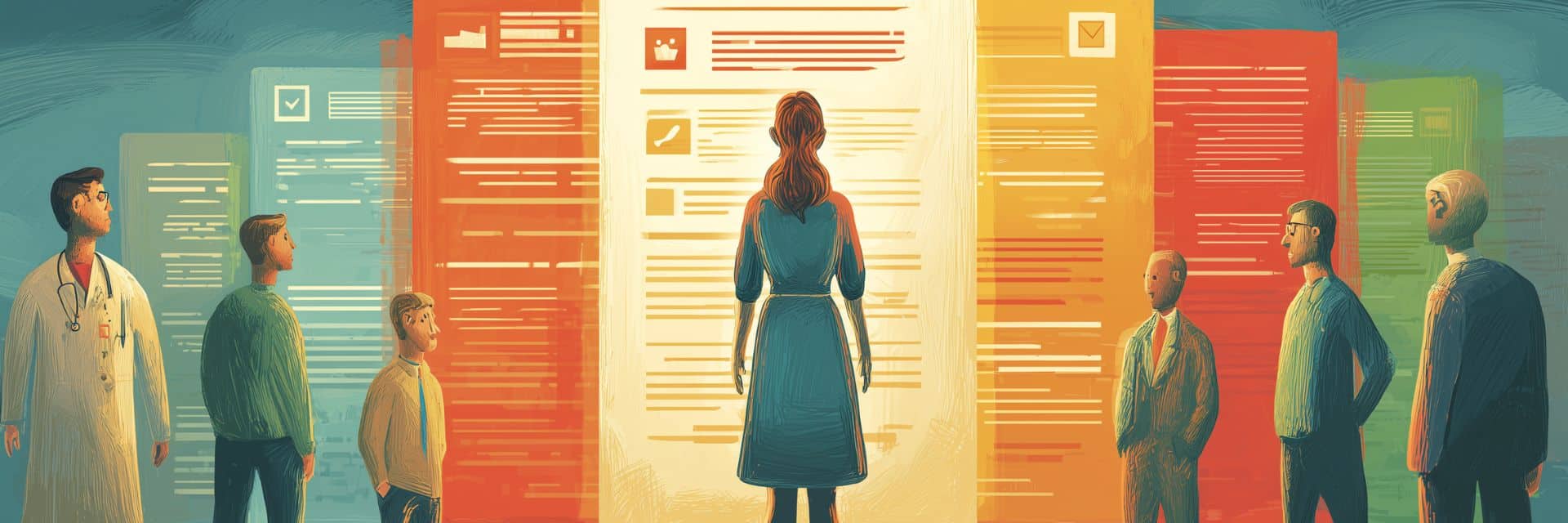The time your clinical team spends on documentation directly impacts your organization’s health. Excessive EHR charting leads to physician burnout, slower patient throughput, and potential revenue loss from inaccurate coding. A strong Clinical Documentation Improvement (CDI) program addresses these challenges. The right CDI software and tools are central to this strategy, helping your team document care accurately and quickly. This improves both operational performance and the well-being of your staff.
What is clinical documentation improvement (CDI)?
Clinical documentation improvement is a process that ensures the information in your medical records is clear, accurate, and complete. It bridges the gap between the clinical care provided and the documentation that describes that care.
A successful CDI program ensures that your clinical documentation:
- Accurately reflects the patient’s severity of illness.
- Supports correct medical coding and billing.
- Provides clear data for quality of care reporting under models like Value-Based Care.
- Leads to proper and timely reimbursement for services rendered.
This focus on detail and accuracy is foundational to both financial stability and high-quality patient care.
How does documentation burden impact healthcare operations?
The administrative weight of documentation extends far beyond the keyboard. When physicians spend hours on EHR charting after their shifts—a phenomenon known as “pajama time”—it creates significant operational challenges.
This burden directly affects your key performance indicators:
- Physician burnout: Excessive documentation is a leading cause of burnout, reducing staff satisfaction and increasing turnover. Studies show this after-hours EHR work is associated with lower professional satisfaction and higher levels of burnout.
- Patient throughput: Every minute a clinician spends on administrative tasks is a minute not spent on patient care, which can slow down patient flow throughout your facility.
- Revenue Cycle Management (RCM): Rushed or incomplete notes often contain coding inaccuracies. These errors lead to claim denials, payment delays, and increased work for your billing department.
- Value-Based Care performance: Inaccurate documentation makes it difficult to prove the quality of care delivered, jeopardizing your performance and reimbursement in VBC contracts.
What are the essential features of a CDI tool?
When evaluating clinical documentation improvement tools, focus on features that deliver immediate value and integrate into your existing workflows. Your solution should provide the following.
Standardized templates
Your tool must allow you to create and deploy a library of pre-approved text templates or shortcuts. This ensures that every member of the clinical team uses the same consistent and accurate phrasing for notes, patient instructions, and reports.
System-wide functionality
Clinical documentation occurs across many applications. An effective tool works everywhere your team works, including inside your EHR, email client, and secure messaging platforms. This removes friction and encourages adoption.
Team sharing and management
Look for a central repository to manage and share content. This gives you control over clinical documentation integrity, allowing you to update information in one place and distribute it to the entire team instantly.
Compliance and security
Any software that handles patient information must meet strict security standards. The vendor must have SOC-2 and SOC-3 certifications and affirm HIPAA compliance. This is a foundational requirement for protecting patient data and your organization.
What are some top clinical documentation improvement software vendors?
The CDI software market includes several established vendors that offer comprehensive, enterprise-level platforms. These solutions often use AI and natural language processing (NLP) to analyze clinical notes, identify documentation gaps, and prioritize cases for review by CDI specialists.
Here are some of the leading products in the space:
- Solventum 360 Encompass System: Formerly produced by 3M, Encompass offers a suite of tools that integrates computer-assisted coding (CAC) with CDI workflows. It’s designed to help large health systems manage documentation and coding from a single platform.
- Microsoft CDE One: Recognized by KLAS as a top performer, Microsoft (previously Nuance) provides an AI-powered platform that helps prioritize CDI worklists and automate parts of the review process. It focuses on improving efficiency for CDI teams.
- Optum CDI 3D: This platform uses NLP to scan patient records and identify potential documentation deficiencies concurrently. It aims to help organizations “get it right upfront” to prevent denials and improve coding accuracy.
- Iodine Software: Iodine uses its proprietary AI engine to analyze clinical data and identify cases with the highest potential for documentation improvement. Its platform is designed to increase the financial impact of CDI programs by focusing specialists on high-priority reviews.
- Dolbey: Dolbey offers a suite of solutions, including Fusion CAC and Fusion CDI, that work together to streamline coding and documentation workflows. They focus on leveraging technology to improve coder and CDI specialist productivity.
- TextExpander: Positioned as a foundational CDI tool, TextExpander empowers individual clinicians to improve documentation speed and accuracy at the point of care. It allows teams to create and share a central library of approved text snippets that can be inserted into any application, including the EHR, with a simple shortcut.
How can Snippets serve as a powerful clinical documentation tool?
Snippets are short, custom abbreviations that instantly expand into longer blocks of pre-written text. Instead of typing the same notes, instructions, or reports repeatedly, your team members type a short command. This simple action is a powerful way to make clinical documentation faster, more accurate, and completely standardized.
What are some Snippet examples for physicians?
For physicians, Snippets dramatically reduce the time spent in the EHR, particularly on common and repetitive documentation tasks. This allows them to complete notes faster and focus more on their patients.
Snippet: ;soap
Expands to:
Subjective:
Objective:
Assessment:
Plan:
Snippet: ;exam.normal
Expands to:
CONSTITUTIONAL: Alert and oriented, in no acute distress.
EYES: EOMI, PERRLA.
HENT: Normal hearing. Oropharynx is clear.
CARDIOVASCULAR: Regular rate and rhythm, no murmurs.
PULMONARY: Lungs clear to auscultation bilaterally.
Snippet: ;dx.ckd4
Expands to:
Chronic Kidney Disease, Stage 4 (non-dialysis dependent), associated with Type 2 Diabetes Mellitus. Patient has been educated on clinical condition and treatment plan.
What are examples of CDI Snippets for nurses?
The entire clinical team benefits from standardized documentation. Nurses and medical assistants can use Snippets to ensure patient communication is consistent and notes are captured accurately.
Snippet: ;discharge.diabetes
Expands to:
You have been diagnosed with Type 2 Diabetes. Please monitor your blood glucose levels twice daily, before breakfast and before dinner. Follow up with your primary care provider in 3 months. Call our office if you experience any symptoms of dizziness, blurred vision, or confusion.
Snippet: ;wound.care
Expands to:
Wound on [location] assessed. Dimensions: [length] x [width] x [depth] cm. Wound bed is pink with no signs of purulent drainage or infection. Surrounding skin is intact. Cleansed with normal saline and a new dressing was applied.
How TextExpander Supports Documentation Improvement
While large-scale CDI platforms are designed for specialized review teams, TextExpander serves as a foundational tool that empowers every single clinician to improve documentation accuracy and speed at the point of care.
TextExpander is not a complex system that requires months of implementation. It’s a lightweight, secure, and flexible utility that works where your clinicians do, inside the EHR and across every other application they use.
Here is how it directly supports your CDI goals:
- Establishes documentation integrity: With a shared Snippet library, you create a single source of truth for clinical terminology. This ensures every note, diagnosis, and instruction uses approved, compliant language, eliminating variability.
- Reduces documentation time: By turning repetitive text into simple shortcuts, TextExpander gives your physicians back valuable time. This directly counters the “pajama time” that leads to burnout.
- Offers a low total cost of ownership: Unlike enterprise software, TextExpander can be deployed quickly with minimal IT resources and requires little training. This allows you to see an immediate return on investment through improved efficiency and staff satisfaction.
By automating the repetitive parts of documentation, TextExpander allows your clinical team to focus on what matters most: providing high-quality patient care.
Is this type of tool secure enough for a healthcare environment?
Yes, provided the software meets the strict security and compliance standards required for handling protected health information (PHI). Security cannot be an afterthought; it must be a core component of the tool.
When evaluating any documentation tool, your security review should confirm a few key points:
- A Business Associate Agreement (BAA) is mandatory. A vendor that handles PHI must be willing to sign a BAA. This legal contract formally outlines the vendor’s responsibility to safeguard your data according to HIPAA regulations.
- Data must be encrypted. All data, whether stored on a server (at rest) or moving across a network (in transit), must be protected with strong encryption.
- You maintain control. The solution should operate within your secure environment on company-managed devices. This ensures that sensitive documentation shortcuts and templates are not accessible on unsecured personal devices.
A compliant tool strengthens your security posture by standardizing information within a controlled platform.
How do shared Snippets improve clinical documentation integrity?
When your entire organization uses a shared library of approved Snippets, you establish a single source of truth for clinical language. This is the foundation of clinical documentation integrity.
Shared Snippets eliminate documentation variability. You remove the risk of clinicians using outdated terminology, personal abbreviations, or inaccurate copy-and-pasted information. Every note, diagnosis, and instruction uses approved, compliant language. This streamlines staff training, supports coding accuracy, and creates a consistent patient record across your entire organization.
Is this type of tool secure enough for a healthcare environment?
Yes, provided the software meets the strict security and compliance standards required for handling protected health information (PHI). Security cannot be an afterthought; it must be a core component of the tool.
When evaluating any documentation tool, your security review should confirm a few key points:
- A Business Associate Agreement (BAA) is mandatory. A vendor that handles PHI must be willing to sign a BAA. This legal contract formally outlines the vendor’s responsibility to safeguard your data according to HIPAA regulations. Refusal to sign a BAA is a clear indicator that a tool is not suitable for healthcare.
- Data must be encrypted. All data, whether stored on a server (at rest) or moving across a network (in transit), must be protected with strong encryption.
- You maintain control. The solution should operate within your secure environment on company-managed devices. This ensures that sensitive documentation shortcuts and templates are not accessible on unsecured personal devices.
A compliant tool strengthens your security posture by standardizing information within a controlled platform.
How does better documentation software lower the total cost of ownership?
Your total cost of ownership (TCO) includes not just the subscription price, but also the costs of deployment, training, and maintenance. While large, complex CDI platforms require significant investment in these areas, a lightweight documentation tool offers a much lower TCO.
Consider these factors:
- Faster deployment: A simple documentation tool can be rolled out to your entire team in days, not months. It requires minimal IT resources compared to a large-scale enterprise software project.
- Rapid adoption: An intuitive tool that works within existing workflows requires little to no formal training. Your team can begin seeing productivity gains immediately, leading to a faster return on investment.
- Reduced administrative overhead: By improving the accuracy of initial documentation, you create downstream savings. Your RCM team spends less time addressing coding queries and claim denials, and you reduce the high costs associated with clinician burnout and staff turnover.
Choosing a tool with a low TCO allows you to solve the core documentation problem without committing to a costly and lengthy project.

